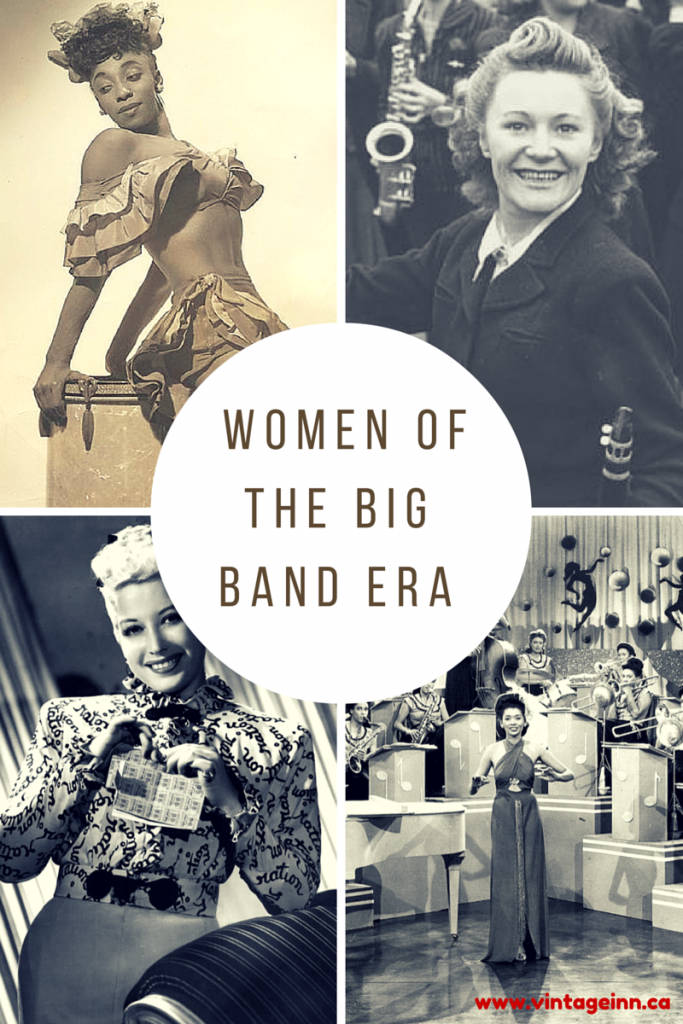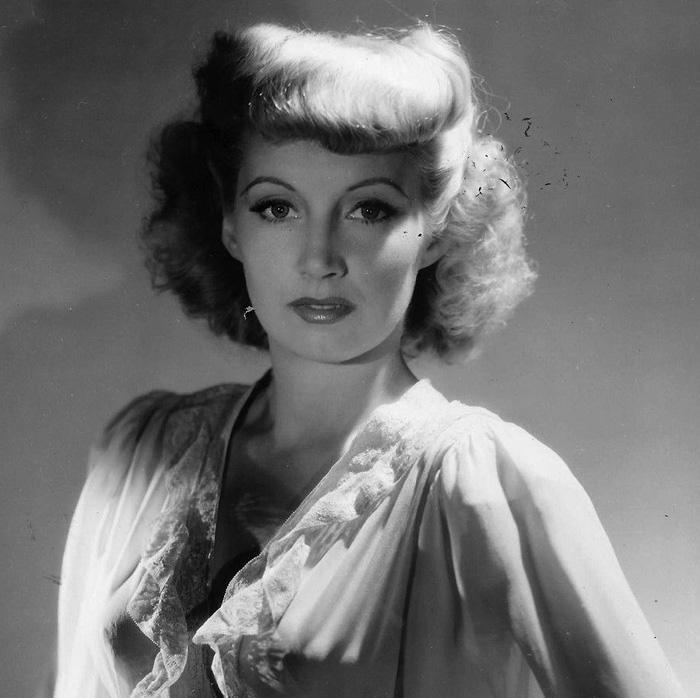
Women of the Big Band Era that Everyone Should Know
2 were Singers in a Big Band
2 were Big Bands
2 were Sister Acts
And 2 were Stars on the Swing Dance Floors
These are just some (not all) of the women of the Big Band Era that I wanted to highlight for today’s post.
Note: I’m focusing most of my post on the “not always mentioned” women. We all adore and know Billie Holiday and Ella Fitzgerald and there is loads written about them so this is why you won’t see them in this post.
For further reading please check out all the posts I have done on this subject on my dedicated page “Women of the Big Band Era Everyone Should Know“. (October 2024 update)
The Girl Groups:
The Boswell Sisters
The Boswell Sisters were a close harmony singing group, consisting of sisters Martha Boswell, Connee Boswell, and Helvetia “Vet” Boswell, noted for intricate harmonies and rhythmic experimentation (source).
They had up 20 hits during the 1930s, including the number-one record “The Object of My Affection” (1935). They also completed two successful tours of Europe, appeared on the inaugural television broadcast of CBS, and performed on Hello, Europe, the first internationally broadcast radio program.
The Sisters were also some of the radio’s earliest stars, making them one of the first hit acts of the mass-entertainment age. In 1934, the Sisters appeared 13 times on the Bing Crosby Entertains radio show on CBS. They were featured in fan magazines, and their likenesses were used in advertisements for beauty and household products (source).
For more information please visit the official Boswell website HERE.
Andrew Sisters

The Andrew Sisters started out as a tribute band to the sisters mentioned above “The Boswells” but quickly found their own style and their own hits turning them into America’s most popular female singing group.
The group consisted of three sisters: contralto LaVerne Sophia, soprano Maxine Angelyn “Maxene”, and mezzo-soprano Patricia Marie “Patty”. After 6 years on the road with various dance bands and touring in vaudville, they had their first hit with “Bei Mir Bist Du Schön”. They followed this success with a string of best-selling records over the next two years and they became a household name by the 1940s.
The sisters sold well over 75 million records (the last official count released by MCA Records in the mid-1970s), starred in 17 Hollywood movies and were established radio personalities. Their 1941 hit “Boogie Woogie Bugle Boy” can be considered an early example of rhythm and blues or jump blues (source).
During their musical career they were very active in their patriotic duty of wartime entertainment. They volunteered their free time to entertain enlisted and wounded men by singing, dancing and signing autographs (source).
For more on the Andrew Sisters please visit their official site HERE.
The Big Band Singers:
Helen Forrest
Helen served as the “girl singer” for three of the most popular big bands of the Swing Era (Artie Shaw, Benny Goodman, and Harry James), thereby earning a reputation as “the voice of the name bands” (source) . She is regarded by some as the best female vocalist of the swing era. With James she had three million selling records and countless Top Ten hits, and for two years running was voted the most popular female vocalist in America (source).
FACT: Helen Forrest was one of the first singers in the big band era whose vocals were featured throughout a full band arrangement. Before this time, big band vocalists usually sang in the middle of a song (Source).
For more information on Helen visit HERE.
Martha Tilton
Martha Tilton, who as one of Benny Goodman’s vocalists in the 1930s was billed as the “Sweetheart of Swing” and appeared on 80 of his recordings (source). She also appeared with Jimmy Dorsey and briefly with Artie Shaw later on in her career.
Fun Story:
Early in her career with the Goodman organization, Martha was singing at the SunnyBrook Ballroom in Pottstown, Pennsylvania. When it came time for Benny to introduce her, he gave her a big buildup: “Here is a pretty gal from Hollywood that’s really going places.” But Martha missed her cue. When she didn’t appear on stage, after a moment Benny ad-libbed, “She’s not going places, she’s already gone.” (source).
For more information on Martha visit HERE.
The Big Bands:
International Sweethearts of Rhythm

The International Sweethearts of Rhythm was the first integrated all women’s band in the United States.
The Sweethearts began in the rural junction of Piney Woods, Miss., in 1937. Lawrence Jones had founded a vocational school there primarily for young Black children and teens and wanted to raise money by forming a student swing band (Source). The original members of the Sweethearts were all students, who were African American or mixed raced, during the 1930s.
Operating from 1938 to 1946, their boom in popularity came during World War II, when many male jazz artists were serving overseas, leaving an opportunity for women to shine their talents at home. Over time, the group attracted some of the country’s strongest female jazz instrumentalists of the era. One of the group’s standout performers was trumpeter Ernestine Carroll, better known as “Tiny Davis,” who was affectionately referred to as the female Louis Armstrong. Armstrong, in fact, was counted among her fans (Source).
Things were not easy for the band. In 1943, two white women joined the ensemble, making it an interracial band performing in the Deep South during Jim Crow. The law forced the band to sleep and eat on their bus because of the segregation laws that prevented them from using restaurants and hotels (among many other issues brought on by this law). In order to navigate this racial divide, the band added “international” to its name. Labeling themselves as international provided the group a social space that allowed the band to rest somewhat outside the Southern racial structure (Source).
Though known mostly to Black audiences the band quickly rose in popularity playing in theatres like the Apollo in Harlem and the Howard Theatre in Washington when the band set a new box office record of 35,000 patrons in one week of 1941. The Sweethearts also gained an international audience when they spent time entertaining African American troops stationed in Europe for the USO.
In 1944 the band was named “America’s No. 1 All-Girl Orchestra” by Downbeat magazine.
For more information on the Sweethearts please take a look at the INCREDIBLE photos from the Smithsonian Museum.
Ivy Benson and Her All-Girl Band

Ivy Benson was an English musician and bandleader, who in 1939 led an all-female swing band to prove to the world that women could be good musicians too. Benson and her band rose to fame in the 1940s, headlining variety theatres and topping the bill at the London Palladium, and became the BBC’s resident house band. Her band (in one form or another) ran from 1939 to 1982. During those years, she gave hundreds of girls and women the chance to become professional musicians.
Fun Fact: Benson’s band had a high turnover of musicians, as they frequently left to marry G.I.s they met while touring. She once commented, “I lost seven in one year to America. Only the other week a girl slipped away from the stage. I thought she was going to the lavatory but she went off with a G.I. Nobody’s seen her since” (source).
For more on Ivy visit HERE.
The Dancers:
Norma Miller-The Queen of Swing

(Update since I wrote this piece in 2016- Norma Passed away in 2019 at 99)
Known to many as the Queen of Swing, and the last living member of Whitey’s Lindy Hoppers, the group that took Lindy Hop — the original swing dance — out of Harlem’s ballrooms and across the world
Norma Miller was first discovered as a gifted young Lindy Hopper when she was just 12 years old. She was found dancing on the sidewalk outside of the Savoy Ballroom (because she was too young to go in) where the music could be heard quite well (source).
Later that year, Miller entered the Savoy Lindy Hop Contest, which was held at the Apollo Theater. Miller entered with one of her high school friends. They won the contest and Norma was asked to join Whitey’s Lindy Hoppers. The group rose to prominence after winning a contest at the Harvest Moon Ball. Miller and the group performed on Broadway and in several motion pictures.
Miller has written several books, appeared in six films and four television series.
In 2003, Miller was given a “National Heritage Fellowship” from the National Endowment for the Arts for creating and continuing to preserve “the acrobatic style swing dance, known as the Lindy Hop (source).
Today Norma currently tours the world, spreading the joy and history of Lindy Hop to new generations of swing dancers and interested audiences.
On a personal level I have been fortunate enough to meet Norma in person when she was visiting Toronto a couple of years ago for a Lindy Hop weekend. She is an incredible woman with so much sass and humor, you cannot help but be instantly drawn to her.
For more on Norma please visit her website HERE.
Here is her most well-known film appearance is in the swing dancing scene in the film Hellzapoppin, featuring Whitey’s Lindy Hoppers.
Jewel McCowan

Jewel by the age of 19 was working as a dancer in music clubs, and doing the Southern California partnered street dance known to them as “Swing”. It was during this time in the late 1930s that a New Jersey Lindy Hop dancer going by the name Dean Collins came to town looking for a partner. He found Jewel, and out of their collaboration came what is now widely regarded as the greatest dancing partnership of the original swing dance era. They would go on to appear in dozens of Hollywood films and shorts.
Jewel did not dance a lot of variations, but instead expressed her powerful voice in her movement and attitude. Jewels swivels (you will know them when you see them) are credited as being without equal (source).
Here is a compilation of Jewel’s movies (and moves).
Well friends, I hope you enjoyed learning about SOME of the women of the Big Band Era. Please share in the comment section below who you enjoyed learning about.
Also, don’t forget to check out ALL the fantastic women I have written about as of January 2024 on my ‘Women of the Big Band Era Everyone Should Know‘ series page.
Further Watching: Please check ‘The Girls in the Band‘ by Judy Chaikin (Producer/ Director)
It’s a fantastic documentary about the history of the all-girl bands and the talented female jazz and big band instrumentalists who continue to struggle for recognition in a man’s world.
Liz 🙂




